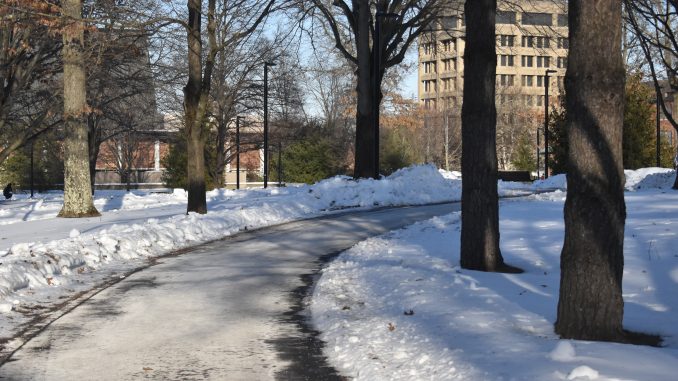
While many students slept away the snow day on Friday, Richard Drosdowich and his team of ground workers were pouring salt and plowing roadways to keep campus up and running. Drosdowich, the campus’ Grounds Supervisor, works with 12 other grounds workers in severe weather to clear the 6.62 miles of pedestrian walkways on campus, along with 3.7 miles of roadways and intersections and 22.7 acres of parking lots. On Friday’s ice storm, one of the worst Drosdowich has encountered, employees were on campus by 2:30 a.m. and stayed as late as 11:00 p.m. They worked throughout the weekend and arrived once again early Monday morning, pouring at least 70 tons of salt on campus roads, parking lots and walkways.
Drosdowich explained the difficulty of clearing campus during a heavy storm like Friday.
“This storm was a tough storm. Ice storms are the toughest. It started raining on Thursday. That turned to ice on Friday,” he said. “It’s the worst you can have on campus because you just chase it around all day. The temperatures drop and the day goes on and everything just keeps freezing.”
While each storm is different, the typical process of preparing for a storm on campus involves Drosdowich either scheduling people to come in early or calling the grounds crew to come in after campus police have notified him. He also calls the Director of Facilities Operations and Maintenance, Gary Buckman, at around 4 to 5 a.m. to discuss the storm and decide whether they think classes should be canceled. They will then make contact with Pres. Christian around this time to advise him whether classes should be delayed or closed, with Pres. Christian making the final decision.
Buckman ensures there is 24 hours of coverage when there is a storm. One or two grounds members will stay overnight, unless more are needed, to sort out complaints regarding slippery spots on campus. Campus is broken down into four areas of A, B, C and D, and workers will be assigned to each area with equipment to clear. Ground workers will try to clear the stairs as fast as possible. There are multiple priority areas, such as handicap routes and the dining hall. Priority areas can also be buildings where events are taking place.
There are a couple of things students can do to help make the snow removal process easier. Drosdowich requests that people don’t park overnight in parking lots if they’re not supposed to. It makes it hard to plow the snow.
“Say five cars park in there, you’ve got to watch out for five cars,” he explained. “When you’re plowing you can’t plow the same way because the cars are in the way.”
Due to the high number of cars parked in the overnight lots during the last three snowstorms on campus, Drosdowich has had to consider talking to campus police about ticketing the cars.
“We try to put the snow in certain areas. It’s so much harder on us to get the lots because it takes that much longer because you can’t plow it the way you want to plow it,” he said.
Students have thanked Drosdowich and his crew for the work they have done in the past.
“It does make the guys happy. Sometimes during the storms we’ll be out there shoveling, or even during the summer, planting flowers, we have students and faculty come up to us and thank us,” he said.
When you’re stepping on salt instead of slipping on ice, remember to be grateful for the tireless work of the Grounds Department and other maintenance staff who have woken up early and stayed late for all of us on campus.

